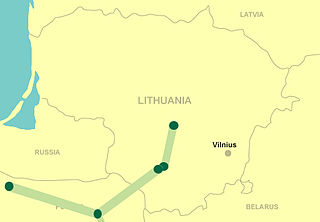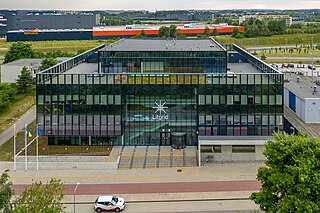
An electrical insulator is a material in which electric current does not flow freely. The atoms of the insulator have tightly bound electrons which cannot readily move. Other materials—semiconductors and conductors—conduct electric current more easily. The property that distinguishes an insulator is its resistivity; insulators have higher resistivity than semiconductors or conductors. The most common examples are non-metals.

Electric power transmission is the bulk movement of electrical energy from a generating site, such as a power plant, to an electrical substation. The interconnected lines that facilitate this movement form a transmission network. This is distinct from the local wiring between high-voltage substations and customers, which is typically referred to as electric power distribution. The combined transmission and distribution network is part of electricity delivery, known as the electrical grid.

A high-voltage direct current (HVDC) electric power transmission system uses direct current (DC) for electric power transmission, in contrast with the more common alternating current (AC) transmission systems.

Electric power distribution is the final stage in the delivery of electricity. Electricity is carried from the transmission system to individual consumers. Distribution substations connect to the transmission system and lower the transmission voltage to medium voltage ranging between 2 kV and 33 kV with the use of transformers. Primary distribution lines carry this medium voltage power to distribution transformers located near the customer's premises. Distribution transformers again lower the voltage to the utilization voltage used by lighting, industrial equipment and household appliances. Often several customers are supplied from one transformer through secondary distribution lines. Commercial and residential customers are connected to the secondary distribution lines through service drops. Customers demanding a much larger amount of power may be connected directly to the primary distribution level or the subtransmission level.

A transmission tower, also known as an electricity pylon or simply a pylon in British English and as a hydro tower in Canadian English, is a tall structure, usually a steel lattice tower, used to support an overhead power line.

The Kontek HVDC is a 170-kilometre (110 mi) long, monopolar 400 kV high-voltage direct current cable between Germany and the Danish island Zealand. Its name comes from "continent" and the name of the former Danish power transmission company "Elkraft", which operated the power grid on the Danish islands Lolland, Falster and Zealand and had the abbreviation "ek". As of today, the cable is operated by Energinet.dk in Denmark and 50Hertz Transmission GmbH in Germany.

The Baltic Cable is a monopolar HVDC power line running beneath the Baltic Sea that interconnects the electric power grids of Germany and Sweden. Its maximum transmission power is 600 megawatts (MW).
The Elbe Project was the name of the first commercial, static high voltage direct current transmission system constructed in the world. The scheme was based on mercury arc valves.
NorNed is a 580-kilometre (360 mi) long high-voltage direct current submarine power cable between Feda in Norway and the seaport of Eemshaven in the Netherlands, which interconnects both countries' electrical grids. It was once the longest submarine power cable in the world. Budgeted at €550 million, and completed at a cost of €600m, the NorNed cable is a bipolar HVDC link with a voltage of ±450 kV and a capacity of 700 MW. NorNed is a joint project of the Norwegian transmission system operator Statnett and its Dutch counterpart TenneT. The cable system itself and the two converter stations were produced by ABB.

Railway electrification using alternating current (AC) at 15 kilovolts (kV) and 16.7 hertz (Hz) are used on transport railways in Germany, Austria, Switzerland, Sweden, and Norway. The high voltage enables high power transmission with the lower frequency reducing the losses of the traction motors that were available at the beginning of the 20th century. Railway electrification in late 20th century tends to use 25 kV, 50 Hz AC systems which has become the preferred standard for new railway electrifications but extensions of the existing 15 kV networks are not completely unlikely. In particular, the Gotthard Base Tunnel still uses 15 kV, 16.7 Hz electrification.
NordBalt is a submarine power cable between Klaipėda in Lithuania and Nybro in Sweden. The purpose of the cable is to facilitate the trading of power between the Baltic and Nordic electricity markets, and to increase the supply and energy security in both markets.

LitPol Link is an electricity link between Poland and Lithuania which connects the Baltic transmission system to the synchronous grid of Continental Europe. It has a capacity of 500 MW and since 2021 it can operate in a synchronous regime.
TenneT is a transmission system operator in the Netherlands and in a large part of Germany.

GKK Etzenricht, an abbreviation of Gleichstromkurzkupplung Etzenricht, meaning Etzenricht HVDC-back-to-back station, was an HVDC back-to-back facility near Etzenricht in the district of Neustadt an der Waldnaab in Bavaria, Germany. It was built on the site of the Etzenricht substation, a 380 kV/220 kV/110 kV-substation, which went into service in 1970 and expanded afterwards several times. The facility was used between 1993 and 1995 for the exchange of power between Germany and the Czech Republic, operated by Bayernwerk AG.

Litgrid AB is a Lithuanian electricity transmission system operator that operates Lithuania's electricity transmission grid. Litgrid is responsible for the integration of the Lithuanian electricity system into the European electricity infrastructure and the common electricity market.
The Kukule Ganga Dam is a 110 m (360 ft) gravity dam built across the Kukule River in Kalawana, Sri Lanka. The run-of-river-type dam feeds an underground hydroelectric power station located approximately 5 kilometres (3.1 mi) away, via tunnel.

The Šiauliai–Jelgava power line is an electricity link (interconnector) in the Baltic transmission system between Lithuania and Latvia. The overhead power line is one of seven interconnections between the two countries and one of the four 330 kV power transmission lines between Lithuania and Latvia.

Harmony Link is a planned submarine power cable between Lithuania and Poland. The purpose of the cable is to finish the transition of the Baltic states from IPS/UPS to the synchronous grid of Continental Europe.












